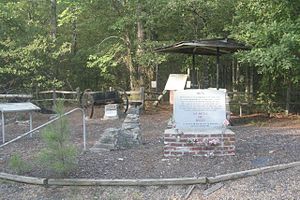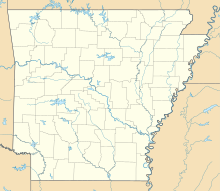Battle of Mark's Mills
| Battle of Marks' Mills | |||||||
|---|---|---|---|---|---|---|---|
| Part of the American Civil War | |||||||
 Battle of Marks' Mills State Historic Site |
|||||||
|
|||||||
| Belligerents | |||||||
|
|
|
||||||
| Commanders and leaders | |||||||
| James Fagan | Francis Drake | ||||||
| Strength | |||||||
| 8,000 | 1,800 | ||||||
| Casualties and losses | |||||||
| 293 | 1,500 | ||||||
|
|
|||||||
The Battle of Marks' Mills (April 25, 1864) occurred in present-day Cleveland County, Arkansas as part of the American Civil War. Confederate Brigadier-General James Fagan, having made a forced march, attacked a train of several hundred wagons, guarded by a brigade of infantry, 500 cavalry, and a section of light artillery under command of Lieutenant Colonel Francis M. Drake of the 36th Iowa, on its way from Camden to Pine Bluff for supplies.
F.M. Drake had a reputation as an Indian fighter; in 1854 he led a wagon train from Iowa to Sacramento California and, while crossing the Nebraska prairie, his train was attacked by an estimated 700 Pawnee warriors. Drake organized and led a spirited defense of his train, and although outnumbered 7 to 1, the attackers were beaten off, reportedly after Drake personally killed their leader with his knife. At the outbreak of the Civil War, Drake was appointed Captain of a cavalry company of Lieutenant Colonel John Edwards' Iowa Southern Border Brigade. Drake participated in numerous skirmishes with that command while clearing northern Missouri of confederates and was appointed commander of the federal supply depot at Hannibal, Missouri. When the 36th Iowa was organized in September 1862, Iowa Governor Samuel Kirkwood appointed Drake Lieutenant Colonel of that regiment. The 36th were veterans, having participated in the Yazoo Pass Expedition, February–April, 1863, the Battle of Helena, July 4, 1863, as well as in every skirmish and battle of the Camden Expedition, including the Battle of Elkins Ferry, April 3–4, 1863, where Drake was in command of the advanced troops of General Fred Steele who forced the crossing of the Little Missouri River, holding the crossing with only two battalions of infantry against 2,500 Confederates.
Following the Federal defeat at the Battle of Poison Spring on April 18, 1864, Major-General Frederick Steele retained possession of Camden while Confederate Major-General Sterling Price continued his ad hoc siege upon Camden from the countryside. As Federal provisions diminished, arrival of much-needed supplies from Pine Bluff convinced Steele that more could be obtained using the Camden-Pine Bluff Road. Steele ordered Drake with over 1,400 infantrymen, artillery and cavalry support, and 240 army wagons to obtain supplies from Pine Bluff. Reinforced on the morning of April 25, 1864 by some 350 additional troops, Drake's command contained approximately 1,800 combatants, including the 43rd Indiana, 36th Iowa and the 77th Ohio plus additional cavalry and artillery. Drake had the reputation of a noted Indian fighter. In 1854 he led a wagon train from Iowa to California that was attacked by an estimated 700 Pawnee warriors on the plains of Nebraska. Drake led a spirited defense of the train, though outnumbered 7 to 1, and reportedly ended the attack when he personally killed the Indian leaders. At the outbreak of the Civil War, Drake was appointed Captain in the Command of Lieutenant Colonel John Edwards of the Iowa Southern Border Brigade and participated in numerous operations to clear Northwest Missouri of Confederates. He was subsequently placed in command of the federal depot at Hannibal, Missouri. When the 36th Iowa was organized in September 1862
...
Wikipedia

